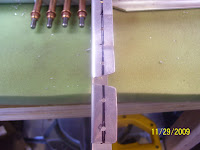
A slightly blurry pic of the dimple die inserted in the bottom of the table as previously described. A level table and a precisely positions dimple die are very important to creating a correct dimple,so care must be taken to set this up correctly before hammering away. Just a final note that the time spent solving the not-wide-enough work bench problem, and finishing the construction of the dimpling table, took a bout 2 days for me to complete. Unfortunately those were the 50 degree days that I might hve been able to finish priming all my parts,which is the last step before final riveting takes place. The cold weather is not helping, and I do have to say that right now I am extremely jealous of those that build airplanes that choose to live in more temperate climates, where they do not have to deal with the cold like we do here in Colorado. Oh well, I just stay patient and find other things to do when its super cold outside! I will show you how parts are cleaned and primed, and the skins are dimpled, in upcoming posts.























